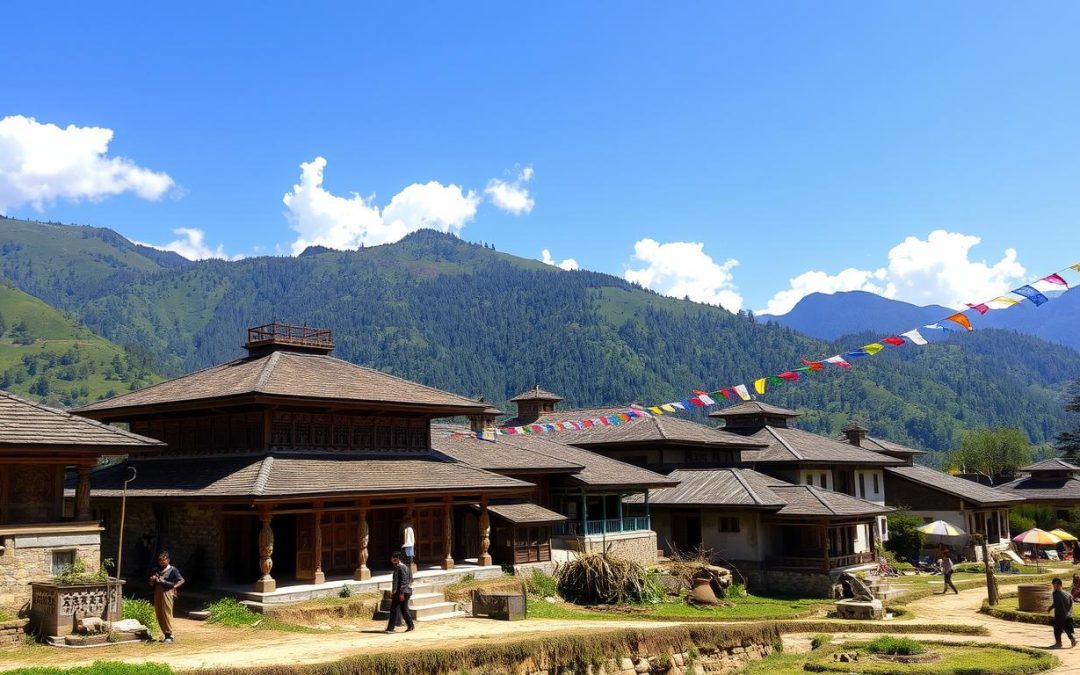Ever wondered how a small Himalayan kingdom keeps its languages alive? Bhutan, between China and India, shows us how. It’s a place where language and culture go hand in hand.
Dzongkha is Bhutan’s national language, spoken by about 160,000 people. It shows the country’s dedication to its culture and unity. Exploring Bhutan’s languages, you find a rich mix of communication.
Bhutan has 22 living languages, from Tibeto-Burman to Indo-European and Dravidian. Each language has its own story of community and survival in the mountains.
Key Takeaways
- Dzongkha is Bhutan’s official national language
- Bhutan hosts 22 distinct living languages
- Languages represent three major language families
- Linguistic diversity reflects cultural complexity
- Bhutan prioritizes language preservation
Introduction to Bhutan’s Linguistic Diversity
Bhutan, nestled in the eastern Himalayas, has a rich language scene. This scene shows the country’s deep cultural roots. Exploring Bhutan’s languages takes you beyond just words.
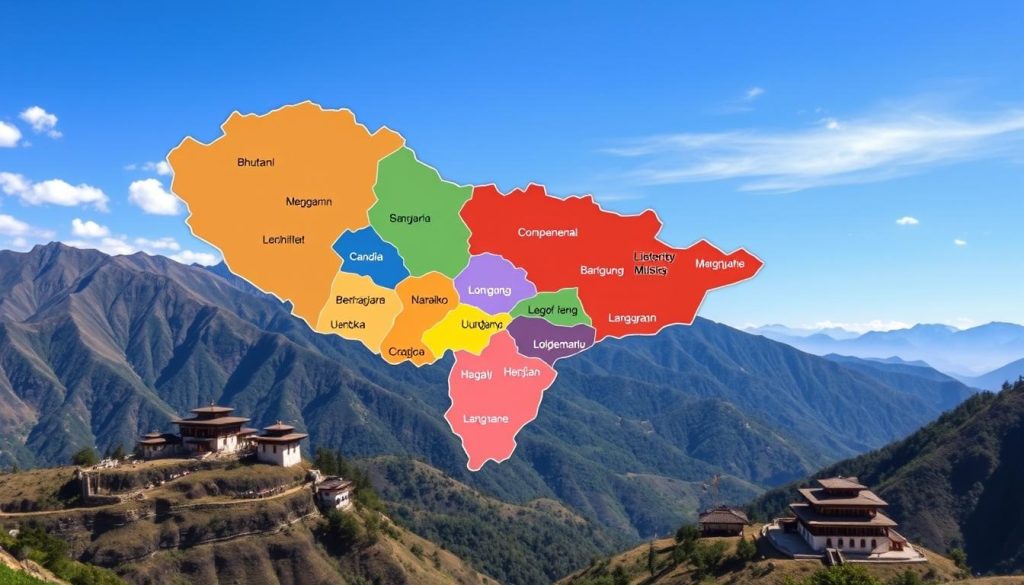
Bhutan’s language world is diverse, with nineteen languages spoken. These languages belong to different families, making a unique way of communicating.
Language Families in Bhutan
Bhutan’s languages fall into three main families:
- Tibeto-Burman (about 75% of languages)
- Indo-European (including Nepali)
- Dravidian (rare, but present)
Historical Language Development
Bhutan’s languages have changed over centuries. Cultural exchanges, migrations, and political shifts have shaped them. Tshangla, for example, is key in eastern Bhutan.
Geographic Language Distribution
Geography shapes Bhutan’s language scene. Different languages are found in different areas:
- Himalayan valleys have unique dialects
- Southern foothills are home to Nepali speakers
- English is common in cities and schools
“Language is the roadmap of a culture. It tells you where its people come from and where they are going.” – Rita Mae Brown
Learning about Bhutan’s languages helps us understand its society. It shows how communication brings people together and keeps traditions alive.
Dzongkha: The National Language of Bhutan
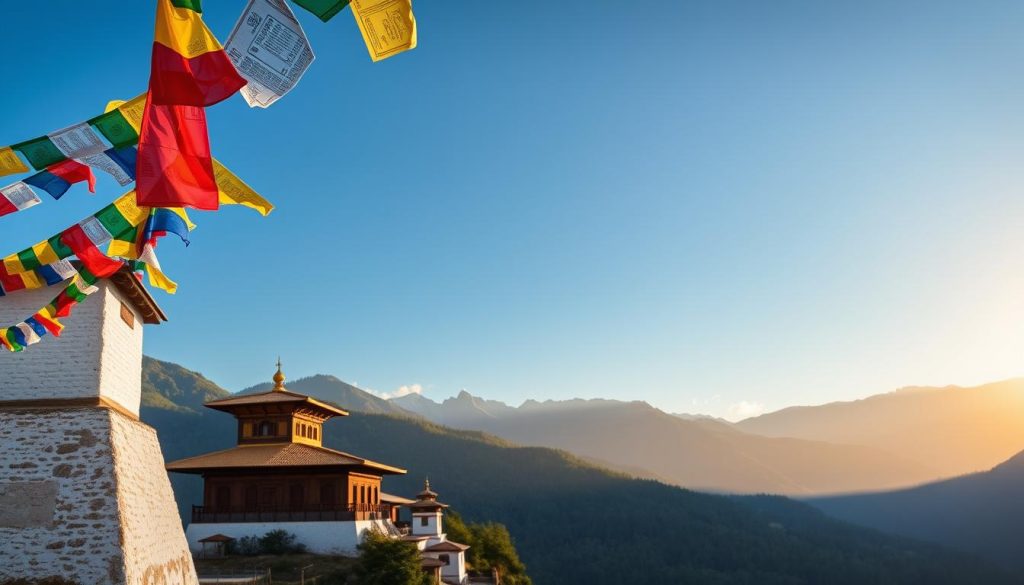
Dzongkha is at the heart of Bhutan’s culture, acting as the national language. It connects the country’s diverse communities. This language comes from the western districts and shows the spirit of the Ngalop people.
Exploring Dzongkha’s roots reveals a rich heritage. It became the national language in 1971. It’s used for government, education, and media. The language uses the elegant Tibetan alphabet, linking it to the region’s history.
“Dzongkha is not just a language, but the soul of Bhutanese national identity.”
Key Characteristics of Dzongkha
- Classified under the Sino-Tibetan language family
- Native to eight western Bhutanese districts
- Features two distinct register tones
- Uses Tibetan script for writing
Dzongkha is linguistically fascinating. It has around 640,000 total speakers and 171,080 native speakers. It has five case-marked nouns and a traditional vigesimal numeral system. This shows deep cultural nuances.
| Language Statistic | Details |
|---|---|
| Native Speakers | 171,080 |
| Total Speakers | 640,000 |
| Official Status | National Language Since 1971 |
| Writing System | Tibetan Alphabet |
Learning Dzongkha is more than just language. It connects traditional Bhutanese culture with modern identity. Students in Bhutan learn Dzongkha every day. This keeps the language alive and important.
Major Tibeto-Burman Languages in Bhutan
Bhutan’s language scene is rich and varied. It shows the country’s deep cultural roots. You’ll find many languages spoken in different areas, each with its own story and importance.
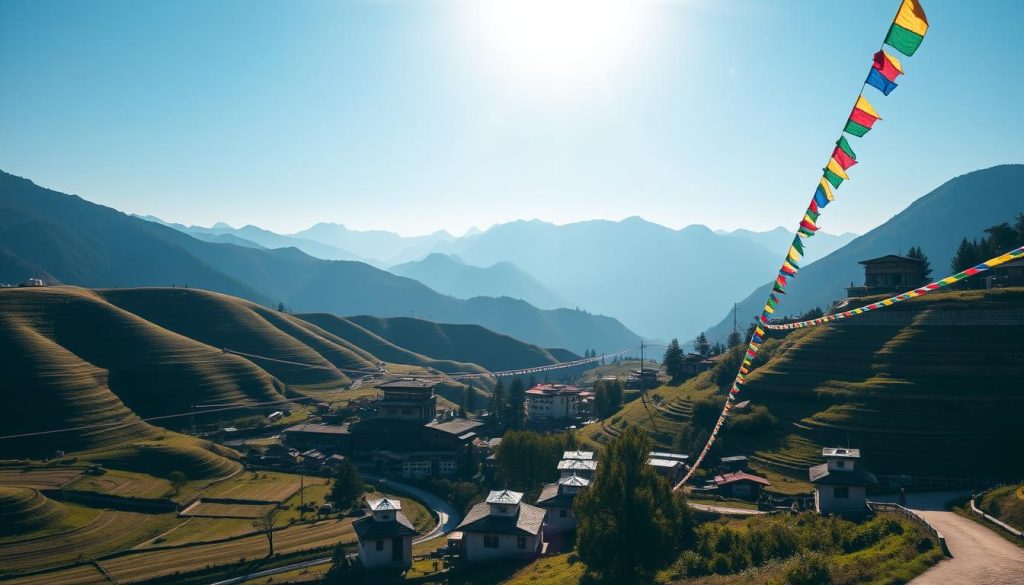
In Bhutan, about 1.2 million people speak Tibeto-Burman languages. Knowing where these languages are spoken helps us see the country’s linguistic variety.
Central Bodish Languages
Central Bodish languages are key in Bhutan. They are closely tied and include:
- Dzongkha (the national language)
- Chocangaca
- Lakha
- Brokkat
- Brokpa
Eastern Bodish Languages
In central Bhutan, Eastern Bodish languages are common. They have their own special features. Some well-known languages in this group are:
- Bumthangkha
- Khengkha
- Kurtöp
- Dzala
- Nyen
- Ole
- Dakpa
- Chali
Other Significant Tibeto-Burman Languages
Beyond Bodish languages, Bhutan has more Tibeto-Burman languages. These add to the country’s linguistic richness:
- Sharchopkha (Tshangla)
- Gongduk
- Lhokpu
“Language is the road map of a culture. It tells you where its people come from and where they are going.” – Rita Mae Brown
Each language in Bhutan is a unique part of its culture. They help keep local identities alive and connect people across the country.
The Role of English in Modern Bhutan
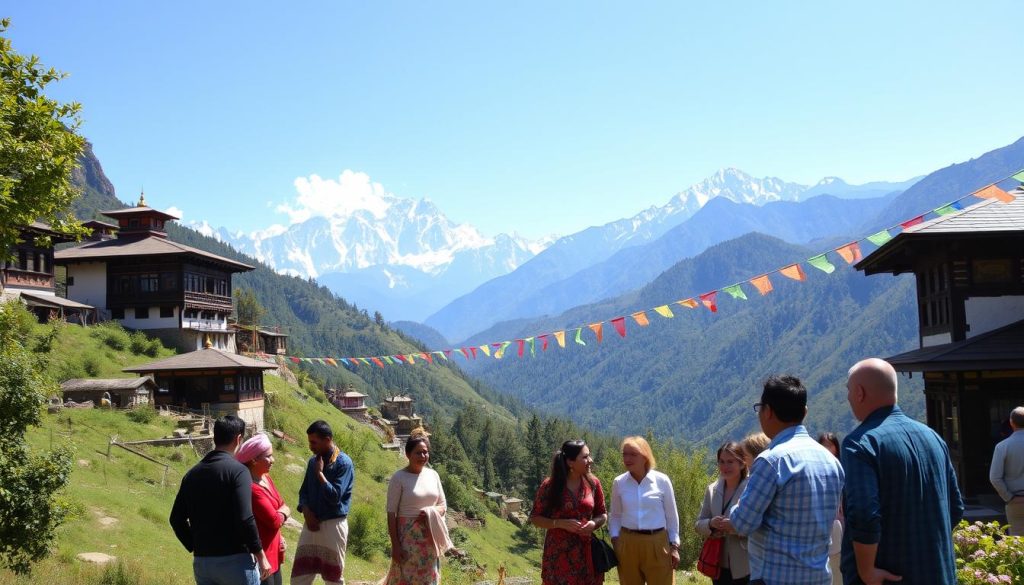
In Bhutan, English has become a key link between old traditions and new global chances. It’s not an official language but is very important for education and work.
The Royal Government of Bhutan sees English as vital for learning and talking. Students learn English to open up more job chances and connect with the world.
- English is the main language taught in many schools
- It helps students get into higher education
- It boosts economic growth and global ties
- It makes communication easier in government and business
Bhutan wants to keep its rich language traditions alive. Schools teach English but also focus on keeping native languages like Dzongkha. This way, the culture stays strong.
“Language is the roadmap of a culture. It tells you where its people come from and where they are going.” – Rita Mae Brown
Bhutan has about 650,000 people and nineteen languages. Its use of English shows a smart mix of global connection and respect for local languages.
Young Bhutanese see English as a door to more chances. They learn it not just for school but as a tool for success in the future.
Nepali Language and the Lhotshampa Community
Bhutan’s language scene is very diverse, with Nepali being a key part. The Lhotshampa community, made up of Bhutanese of Nepalese origin, has greatly shaped the country’s culture.
Cultural Significance of Nepali Speakers
Nepali speakers in Bhutan add a lot to the country’s culture. Their traditions include:
- Rich culinary practices
- Distinctive musical traditions
- Unique festivals and celebrations
- Agricultural expertise in southern regions
Geographic Distribution
The Lhotshampa community mainly lives in southern Bhutan. They are found in places like Samchi, Sarpang, and Chirang. About 265,000 Nepali speakers add to the area’s cultural mix.
| Region | Percentage of Nepali Speakers |
|---|---|
| Southern Bhutan | 25-35% |
| Samchi District | 40% |
| Sarpang District | 35% |
Integration Challenges and Opportunities
The Lhotshampa community faces big challenges in keeping their language and culture alive. They have been displaced and face issues with social integration.
“Language is the roadmap of a culture. It tells you where its people come from and where they are going.” – Rita Mae Brown
Despite these challenges, the Nepali-speaking community keeps its rich culture alive. They also help shape Bhutan’s national identity. Programs that promote education and cultural exchange are helping to bridge gaps and celebrate linguistic diversity.
Indigenous and Minority Languages
Bhutan’s language scene is filled with fascinating indigenous tongues. These languages share unique cultural stories. The Brokpa and Tshangla communities are among the most interesting linguistic minorities in this Himalayan kingdom.
In remote mountain areas, many rare languages struggle to survive. Some of these include:
- Lhokpu: Spoken by a small community in western Bhutan
- Gongduk: A critically endangered language with fewer than 100 speakers
- Olekha: Another unique linguistic treasure with limited speakers
The Tshangla language is spoken by about 170,000 people in eastern Bhutan. It’s a vibrant example of linguistic diversity. It also reaches into northeastern Indian states and Tibet.
“Language is the roadmap of a culture. It tells you where its people come from and where they are going.” – Rita Mae Brown
Brokpa speakers live in isolated mountain communities. They keep linguistic traditions alive. These traditions are key to understanding Bhutan’s cultural heritage. However, younger generations are often drawn to more common languages.
Linguists and cultural preservationists are working hard to save these languages. They aim to document and protect these treasures. Their goal is to make sure these languages are not lost to time.
- Documentation projects are recording rare language structures
- Community engagement supports language revitalization
- Educational initiatives help preserve linguistic diversity
Language Preservation and Education Policies
Bhutan is a special country that works hard to keep its language alive. It wants to hold onto its traditions but also move forward. This balance is key to its language policies.
The government in Bhutan has set up plans to protect and grow its native languages. Dzongkha is a big focus. These plans go beyond just keeping the language alive. They aim to develop and use it in schools.
Government Language Initiatives
Bhutan’s language policies are forward-thinking. They include:
- Standardizing Dzongkha across different regions
- Developing comprehensive language teaching materials
- Supporting research into local language documentation
- Protecting minority language communities
Educational System and Language Teaching
In Bhutan, education is special because it values many languages. English is the main teaching language. But Dzongkha, the national language, gets a lot of attention too.
| Language | Educational Role | Percentage of Speakers |
|---|---|---|
| Dzongkha | National Language | 24% |
| English | Instruction Medium | Widely Used |
| Tshanglakha | Regional Language | 28% |
Cultural Preservation Through Language
In Bhutan, language is more than just a way to talk. It connects people across time. By teaching native languages, Bhutan keeps its culture alive and strong.
Language is the roadmap of a culture. It tells you where its people come from and where they are going.
The Roman Dzongkha transcription system, started in 1991, shows Bhutan’s dedication. It makes the language easy to use and understand in today’s world.
Border Languages and Regional Influences
Bhutan’s language scene goes beyond its borders, showing a rich mix of languages. This mix connects Bhutan to its neighbors. Tshangla and other border languages show the cultural exchanges between Bhutan and its neighbors.
The border areas of Bhutan are linguistically diverse, crossing political lines. Languages like Sikkimese, Groma, and Toto show the strong ties between Bhutan and India and Tibet.
- Sikkimese: Spoken by Bhutia people along the Sikkim-Bhutan border
- Groma: Used by Tibetan communities near the Tibet-Bhutan frontier
- Toto: Spoken by the Toto tribe near Bhutan’s border with West Bengal
“Languages are the roadmaps of a culture. They tell you where its people come from and where they are going.” – Rita Mae Brown
Nepali is important in Bhutan’s border areas, with about 265,000 Lhotshampa people in the south. This shows the complex cultural interactions that shape Bhutan’s language identity.
| Border Language | Approximate Speakers | Primary Region |
|---|---|---|
| Sikkimese | Undetermined | Sikkim-Bhutan Border |
| Groma | Limited speakers | Tibet-Bhutan Border |
| Tshangla | 138,000 | Eastern Bhutan |
| Nepali | 265,000 | Southern Bhutan |
These border languages act as bridges, linking Bhutan’s culture to its neighbors. They show how languages change through migration, trade, and cultural exchange.
Conclusion
Bhutan’s language scene is a true marvel of cultural strength and variety. It has 22 living languages in its small area of 38,394 square kilometers. This is impressive, given its population of just 750,000 people.
Dzongkha is the national language, holding the country’s linguistic identity tight. Tshangla and Nepali add important layers to how people communicate. English is key for connecting with the world, keeping Bhutan’s traditions alive while reaching out globally.
The language scene in Bhutan is more than just talking—it’s about keeping culture alive, telling stories of the past, and showing how people relate to each other. Each language, from common Dzongkha to rare Brokkat with only 300 speakers, is a special part of Bhutan’s rich cultural mix.
As Bhutan walks the fine line between old and new, its many languages stand as a strong symbol of who they are. Learning about Bhutan’s languages gives deep insights into its society. It shows how Bhutan keeps its heritage alive in today’s world.
The above is subject to change.
Check back often to TRAVEL.COM for the latest travel tips and deals.
Here are some Tours & Sightseeing suggestions that might pique your interests!
